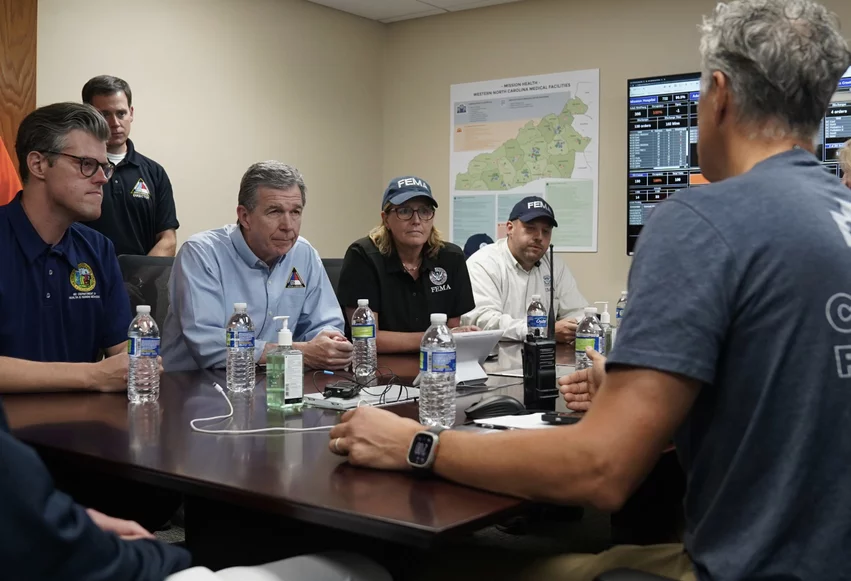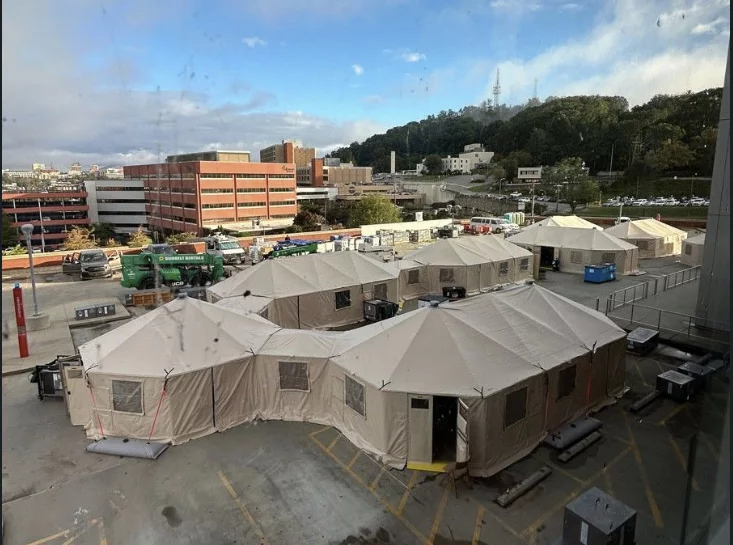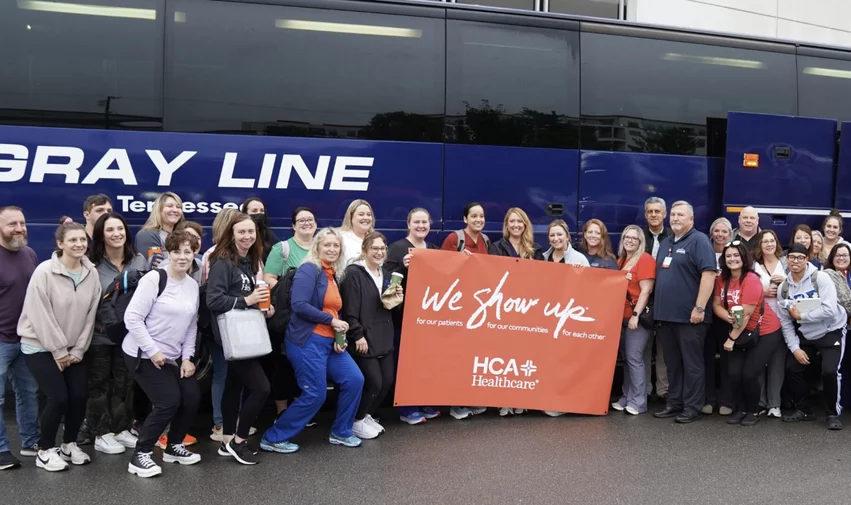Asheville's Mission Hospital is in the center of Hurricane Helene disaster recovery
Mission Hospital, part of HCA Healthcare, is not only the largest hospital in Asheville, North Carolina, it is also the largest employer in the city. When Hurricane Helene plowed into the Appalachian region, the hospital was both a victim of the storm and the salvation point for the injured and first responders. Its preparations for the storm, and subsequent disaster response, will likely become a model for future recovery planning.
Despite being located in a city devastated by the storm, Mission Hospital was prepared and maintained operations through the unfolding disaster and its aftermath. Hospital officials detailed how that were able to do this during a press conference Oct. 5.
Despite the storm damage widely expected to be limited to the gulf coast region, as is usually the case with hurricanes, the hospital prepared for the worst just in case, because the path of Helene was projected into the Appalachian region, a couple hundred miles inland. That pre-planning paid off when the hurricane unexpectedly became the second worst to hit mainland U.S. in the past 50 years, trailing only Hurricane Katrina.
Before the storm arrived, the hospital sent notice to more than 1,000 staff to plan on sleeping in the hospital between shifts. Leadership also brought in extra staff to ensure the care of the 700 patients onsite were cared for. The hospital stockpiled supplies, which turned out to be necessary when Asheville was slammed by floodwaters and the city became the poster child in national headlines as the epicenter for the disaster.
"Since the storm made landfall, Mission Hospital has been providing full services for a significant influx of patients. We have delivered more than 50 babies and have cared for more than 1,800 patients during that time, and providing essential medical care in the face of extraordinary circumstances," Greg Lowe, Mission Health CEO, said during the press conference.
"HCA healthcare has mobilized hundreds of additional staff to bolster our operations, including nurses, engineers, security personnel, and emergency operations teams. These dedicated individuals have been working around the clock to en sure the continuity of healthcare services in our community. It was difficult during the storm. We had a rough ride for the first 24 hours, but our teams were onsite. We brought additional teams onsite to sleep in the facility, to be available to care for our patients around the clock. Resources began to arrive at our facility almost immediately, with food, water, fuel, and anything we needed,"he added.
Helicopters have been brought in to ensure the Mission Hospital is continually supplied, despite the road to access it being washed away by the heavy stormsurge waters of Hurricane Helene.
Extensive damage
The storm and flooding took out the hospital's power supply and the municipal water supply of Asheville. But, the hospital had backup generators, which they kept running for days after the storm to maintain power. HCA also arranged for a large numbers of tanker trucks to ferry water in from outside the disaster zone in a continuous loop. This has enabled the hospital to restore its pressurized water system on its own while the city water system is out of commission. As of time of writing, it remains out of commission.
Mission Hospital was able to restore running water for sinks, showers and toilets. Prior to this, Lowe said the hospital had to use buckets of water to manually flush toilets, which was a major undertaking for a large hospital.
"There was a lot of commotion in the first 24 hours of the storm, we lost city water, a vital resource, so we deployed our entire team to provide buckets of water to flush all toilets, so we had potable water on every unit. Since then, we have been able to pressurize our water system and we have been able to have showers, toilets and sinks available. At no time were our patients at risk. We had infection prevention teams testing water and rounding the hospital, double checking the safety of our patients," Lowe explained.
As additional help arrived from hospitals outside the area and a federal field hospital was established in a parking lot at Mission Hospital, they began to send staff home to survey the damage and try to get in touch with family members. With stores and gas stations closed, supply depots were set up for staff.
"We understand the fatigue and the unique situations that our staff is in, where they might not have heard from their family members. They did not know the status of their homes. So we set up minimarts and megamarts in every one of our hospitals to provide food, water, and cleaning supplies. We set up megamarts where we had tanker trucks full of fuel, where we fueled over 5,000 employees' vehicles to be able to them get back and forth to their homes and return to care for the patients in need," Lowe said.
North Carolina Senator Thom Tillis (R) said the field hospital helped offer flex capacity outside the building, which was desperately needed. He said the field hospital also has allowed the hospital to decompress as large behind the scenes efforts were being made to restore functionality to the hospital.
"At the same time that they are providing critical healthcare, they're dealing with the circumstances of employees who have been devastating situations at home that they need to deal with," explained Tillis, who also spoke at the press conference.
Federal help relieved pressure
HCA established communication and collaboration with FEMA immediately to coordinate what resources they needed to keep Mission Health operational. Within a day or two after the storm, Lowe met with North Carolina Governor Roy Cooper (D), FEMA Administrator Deanne Criswell and the heads of the state's departments of emergency response and health and human services.
One key help was the federal government setting up a field hospital in the parking lot of Mission Hospital to help offload the massive influx of patients. The U.S. Department of Health and Human Services (HHS) Administration for Strategic Preparedness and Response (ASPR) National Disaster Medical System (NDMS) medical teams brought in 300 medical, public health, and response personnel to North Carolina. They came with 386 tons of medical supplies and equipment to provide support at two hospitals and two emergency medical shelters. More responders are deployed to provide support in some of the hardest hit areas of the state.
"To understand the level of impact they can have, three days ago the hospital's emergency department occupancy was over 200%. Within two days with the help of our NDMS team, the hospital ED is now below 50%. A few days ago the hospital had more than 100 patients waiting in the emergency department. Yesterday, the hospital had one patient waiting to be seen. That provides a level of care for this community that we are proud to support, but it also allows the doctors and nursed that work at this hospital to take care of their families and their homes, because we know that they've ben impacted too," explained Dawn O'Connell, HHS assistant secretary for preparedness and response.
"The National Disaster Medical System has played a vital role in our response and to assist in our efforts. The Disaster Medical Assistance Team (DMAT) teams are operating at Mission Hospital in Asheville and its First Pine and Blue Ridge regional hospitals," Lowe explained.
He said the teams are helping to greatly reduce the strain on the emergency department personnel.The ASPR medical tent complex established at Mission Hospital is providing care for all trauma, cardiac, stroke emergencies and routine care.
Recovery continues as patients arrive
Mission Health is beginning to look at restoring operations at its secondary, more remote facilities, officials said. Now that the first wave of trauma patients from the disaster have received care, there is now a growing concern about a possible second wave of patients coming in due to bacterial infections caused by storm waters, especially skin and respiratory illnesses.
The hospital is coordinating with local and state health departments to manage resources to meet its operational needs.
"Despite the challenges we face, our commitment to providing exceptional care to our patients remains steadfast. We are working tirelessly to restore essential services and ensure that our community has access to resources they need to recover from this disaster," Lowe said.




